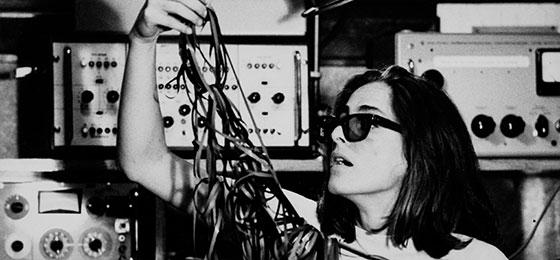Research into new audio experience resonates at Tinguely Museum in Basel

Research into new audio experience resonates at Tinguely Museum in Basel A project funded by the SNSF is investigating the audio phenomena and sound culture associated with radio. As part of this work, an algorithm has been developed to search radio archives using sound-based criteria. Visitors to the "Radiophonic Spaces" exhibition at Basel’s Tinguely Museum can explore some of the findings.
Radio has been on the airwaves for over a century. As a result of digitalisation, the medium is now undergoing a complete shake-up. This transformation is also impacting stations such as the Swiss national broadcaster SRF, which is currently restructuring. The research project "Radiophonic Cultures – Sonic environments and archives in hybrid media systems" funded by the Swiss National Science Foundation (SNSF) has taken the current situation as an opportunity to examine the way radio, as a cultural technique, has changed audio environments.
The researchers took a particularly close look at sound art in the context of radio, as well as the question of the new opportunities that digitalisation is opening up. Archives came in for special attention: "Although archives are repositories, they are increasingly becoming production venues", explains Ute Holl, Head of Research Projects at the University of Basel’s Media Sciences Institute. Artists are making greater use of radio archives as a source of material from which to create new works.
Algorithm-driven archive searches
The research undertaken for «Radiophonic Cultures» spun off a project that has created new ways of sorting archive resources by applying an algorithm to search them by sound criteria. Findings from this new technique are featured in the "Radiophonic Spaces" exhibition at the Tinguely Museum in Basel. They make contemporary and historical, familiar and less well-known aspects of radio art tangible. "Visitors to the exhibition will be able to hear for themselves how the distinctions between radio and sound, noise and music have shifted," explains Ute Holl.
"There’ll be more to hear than to see," admits Andres Pardey, Vice-Director of the Tinguely Museum. Visitors will be given headphones and specially programmed smartphones. As they make their way round the exhibition, they trigger brief excerpts from works by artists such as Antonin Artaud, John Cage and Milo Rau. Anyone who wants to hear in full one of the more than 200 broadcasts from which the excerpts were taken can book to do so at the Museum.
Invitation to keep listening
"That way, people will be able to respond spontaneously to what they hear," explains Pardey. Consequently, visitors will enjoy a radio experience similar to real-life FM broadcasting. They can scan all stations until they hear a piece of music, a voice or a tone sequence that makes them want to keep listening.
The exhibition at the Tinguely Museum will be accompanied by a series of lectures organised by the Media Sciences Seminar at the University of Basel, which will not only present real-life practice and theoretical considerations, but also subject them to critical scrutiny.
The "Radiophonic Cultures - Sonic environments and archives in hybrid media systems" project was financed by the SNSF’s Sinergia funding scheme and is a collaboration between the University of Basel, Bauhaus-Universität Weimar and the FHNW Academy of Music. The "Radiophonic Spaces" exhibition is the result of cooperation between the University of Basel and the Tinguely Museum, Bauhaus-Universität Weimar and the Berlin Haus der Kulturen der Welt. It will run until 27 January 2019 at the Tinguely Museum, from 1 November to 10 December 2018 at Haus der Kulturen der Welt in Berlin, and at the University Library in Weimar from 26 July to 19 September 2019. It will run until 27 January 2019 at the Tinguely Museum, from 1 November to 10 December 2018 at Haus der Kulturen der Welt in Berlin, and at the University Library in Weimar from 26 July to 19 September 2019.
Contact
Links
- Website Radiophonic Cultures
- Download image: (JPEG)Audio culture is changing. Here Argentinian composer Beatriz Ferreyra is struggling with a knot of tapes – something that no longer happens in the digital audio age. © Bernard Perrine
- SNF-project: Radiophonic Cultures - Sonic environments and archives in hybrid media systems